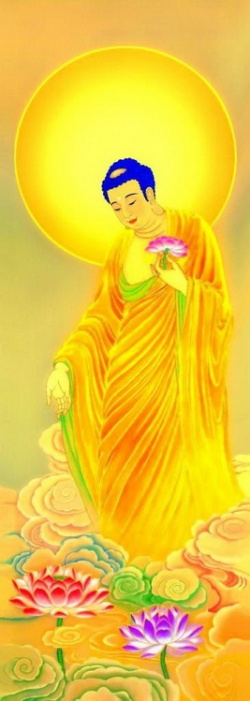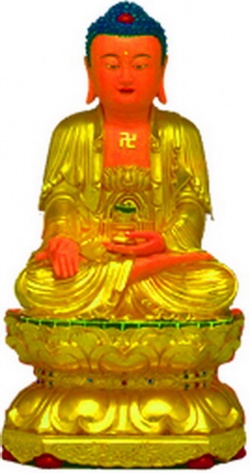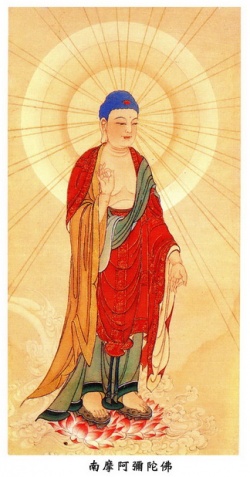Difference between revisions of "Ceremony of Sukhavati"
| Line 1: | Line 1: | ||
[[File:29e.jpg|thumb|250px|]][[File:Amido.JPG|thumb|250px|]][[File:Amitabha 02.jpg|thumb|250px|]] | [[File:29e.jpg|thumb|250px|]][[File:Amido.JPG|thumb|250px|]][[File:Amitabha 02.jpg|thumb|250px|]] | ||
| + | |||
| + | |||
| + | |||
| + | |||
| + | |||
| + | |||
| + | |||
| + | |||
| + | |||
===Introduction=== | ===Introduction=== | ||
| Line 13: | Line 22: | ||
:IV. Reading of [[sukhavati]] [[chant]] and burning of the photograph. | :IV. Reading of [[sukhavati]] [[chant]] and burning of the photograph. | ||
| − | As part of the [[meditation]] section, a session of [[tonglen]] for the deceased can be performed. The photograph is [[attached]] to a chopstick, which is then placed in a [[bowl]] of {{Wiki|rice}} or sand. The picture is lit at the beginning of the last section of the [[chant]] (May they be free from the [[ayatanas]]…). The words [[Namo]] Amitabhaya HRI are repeated until the photograph has become ash and the smoke has dissipated. The {{Wiki|rice}} or sand is considered an [[offering]] and should be scattered in a natural setting, away from a busy or trafficked area. The ocean, streams, a mountain or hilltop are good locations. | + | As part of the [[meditation]] section, a session of [[tonglen]] for the deceased can be performed. The photograph is [[attached]] to a chopstick, which is then placed in a [[bowl]] of {{Wiki|rice}} or sand. The picture is lit at the beginning of the last section of the [[chant]] (May they be free from the [[ayatanas]]…). The words [[Namo]] Amitabhaya [[HRI]] are repeated until the photograph has become ash and the smoke has dissipated. The {{Wiki|rice}} or sand is considered an [[offering]] and should be scattered in a natural setting, away from a busy or trafficked area. The ocean, streams, a mountain or hilltop are good locations. |
The [[buddhist]] [[view]] is that the deceased remains in the [[bardo]] up to 49 days after their [[death]]. A second {{Wiki|ceremony}}, similar to the first, can be conducted on the 49th day of the person's [[death]]. For more [[information]], see texts such as the [[Tibetan Book of the Dead]] and the {{Wiki|Tibetan Book of Living and Dying}}. | The [[buddhist]] [[view]] is that the deceased remains in the [[bardo]] up to 49 days after their [[death]]. A second {{Wiki|ceremony}}, similar to the first, can be conducted on the 49th day of the person's [[death]]. For more [[information]], see texts such as the [[Tibetan Book of the Dead]] and the {{Wiki|Tibetan Book of Living and Dying}}. | ||
| − | HRI | + | [[HRI]] |
In the profundity and [[brilliance]] of [[dharmakaya]]<br/> | In the profundity and [[brilliance]] of [[dharmakaya]]<br/> | ||
| Line 23: | Line 32: | ||
In the magnificent and victorious [[vision]]<br/> | In the magnificent and victorious [[vision]]<br/> | ||
We proclaim the [[jñana]] of [[Amitabha]].<br/> | We proclaim the [[jñana]] of [[Amitabha]].<br/> | ||
| − | You are in the state of [[simplicity]] and you are free from [[fetters]].<br/> | + | You are in the [[state]] of [[simplicity]] and you are free from [[fetters]].<br/> |
You have actually [[attained]] the fundamental [[enlightenment]].<br/> | You have actually [[attained]] the fundamental [[enlightenment]].<br/> | ||
Please look upon us.<br/> | Please look upon us.<br/> | ||
| Line 34: | Line 43: | ||
NAMO AMITABHAYA SAMAYA TISTUAM | NAMO AMITABHAYA SAMAYA TISTUAM | ||
| − | Please accept drinking [[water]], [[flowers]], [[incense]], light, [[perfume]], [[food]], and {{Wiki|music}}.<br/> | + | Please accept drinking [[water]], [[flowers]], [[incense]], {{Wiki|light}}, [[perfume]], [[food]], and {{Wiki|music}}.<br/> |
I praise your magnificent [[wisdom]] and power.<br/> | I praise your magnificent [[wisdom]] and power.<br/> | ||
You can {{Wiki|liberate}} all [[sentient beings]] with one glance of your [[prajña]] and [[upaya]].<br/> | You can {{Wiki|liberate}} all [[sentient beings]] with one glance of your [[prajña]] and [[upaya]].<br/> | ||
| Line 48: | Line 57: | ||
May they be free from the [[ayatanas]].<br/> | May they be free from the [[ayatanas]].<br/> | ||
| − | May they attain a state of [[liberation]].<br/> | + | May they attain a [[state]] of [[liberation]].<br/> |
May the [[merit]] of the [[sangha]] provide [[eternal]] companionship for them.<br/> | May the [[merit]] of the [[sangha]] provide [[eternal]] companionship for them.<br/> | ||
May the [[blessings]] of the [[teacher]] lead them on their journey.<br/> | May the [[blessings]] of the [[teacher]] lead them on their journey.<br/> | ||
May their relatives and companions proceed with them on their journey.<br/> | May their relatives and companions proceed with them on their journey.<br/> | ||
| − | NAMO AMITABHAYA HRI | + | NAMO AMITABHAYA [[HRI]] |
==Glossary== | ==Glossary== | ||
| − | [[Amitabha]]. A [[Tibetan]] [[deity]]. This is the red [[dhyani buddha]] associated with the [[fire]] [[mandala]]. [[Amitabha]] is also associated with two important [[deities]] [[Chenrezig]] and [[White Tara]]. | + | [[Amitabha]]. A [[Tibetan]] [[deity]]. This is the [[red]] [[dhyani buddha]] associated with the [[fire]] [[mandala]]. [[Amitabha]] is also associated with two important [[deities]] [[Chenrezig]] and [[White Tara]]. |
[[Avalokiteshvara]]. (Tib. [[Chenrezig]]) The [[bodhisattva]] [[embodying]] the [[compassion]] of all the [[Buddhas]]. Depicted holding the [[wish-fulfilling gem]] between folded hands. One of the eight main [[bodhisattvas]]. The [[mantra]] associated with this bodhisattiva is known as the [[king]] of [[mantras]], [[OM MANI PEME HUNG]]. | [[Avalokiteshvara]]. (Tib. [[Chenrezig]]) The [[bodhisattva]] [[embodying]] the [[compassion]] of all the [[Buddhas]]. Depicted holding the [[wish-fulfilling gem]] between folded hands. One of the eight main [[bodhisattvas]]. The [[mantra]] associated with this bodhisattiva is known as the [[king]] of [[mantras]], [[OM MANI PEME HUNG]]. | ||
| Line 63: | Line 72: | ||
[[Ayatanas]]. These are the six sensory [[objects]] of [[sight]], [[sound]], {{Wiki|smell}}, {{Wiki|taste}}, and [[body]] [[sensation]]; the [[six sense]] [[faculties]], the [[visual]] sensory {{Wiki|faculty}}, the {{Wiki|auditory}} sensory {{Wiki|faculty}}, etc., and the six sensory [[consciousnesses]], the [[visual consciousness]], the [[auditory consciousness]], etc. They make up the eighteen constituents for [[perception]]. | [[Ayatanas]]. These are the six sensory [[objects]] of [[sight]], [[sound]], {{Wiki|smell}}, {{Wiki|taste}}, and [[body]] [[sensation]]; the [[six sense]] [[faculties]], the [[visual]] sensory {{Wiki|faculty}}, the {{Wiki|auditory}} sensory {{Wiki|faculty}}, etc., and the six sensory [[consciousnesses]], the [[visual consciousness]], the [[auditory consciousness]], etc. They make up the eighteen constituents for [[perception]]. | ||
| − | [[Bardo]]. (Tib.) An {{Wiki|interval}} or gap; In particular the [[intermediate state]] between the end of one [[life]] and [[rebirth]] into another. [[Bardo]] can also be divided into six different levels; the [[bardo]] of [[birth]], [[dreams]], [[meditation]], the moment before [[death]], the [[bardo of dharmata]] and the [[bardo of becoming]]. | + | [[Bardo]]. (Tib.) An {{Wiki|interval}} or gap; In particular the [[intermediate state]] between the end of one [[life]] and [[rebirth]] into another. [[Bardo]] can also be divided into six different levels; the [[bardo]] of [[birth]], [[dreams]], [[meditation]], the [[moment]] before [[death]], the [[bardo of dharmata]] and the [[bardo of becoming]]. |
[[Bodhisattva]]. (Tib. [[chang chup sem pa]]) “Heroic [[mind]]” [[Bodhi]] means blossomed or [[enlightened]], and [[sattva]] means heroic [[mind]]. Literally, one who exhibits the [[mind]] of [[enlightenment]]. Also an {{Wiki|individual}} who has committed him or herself to the [[Mahayana path]] of [[compassion]] and the [[practice of the six paramitas]] to achieve [[buddhahood]] to free all [[beings]] from [[samsara]]. These are the [[heart]] or [[mind]] [[disciples]] of the [[Buddha]]. A [[bodhisattva]] can be {{Wiki|physically}} {{Wiki|present}} in our [[world]] or abide in domains of more {{Wiki|subtle}} [[manifestation]]. | [[Bodhisattva]]. (Tib. [[chang chup sem pa]]) “Heroic [[mind]]” [[Bodhi]] means blossomed or [[enlightened]], and [[sattva]] means heroic [[mind]]. Literally, one who exhibits the [[mind]] of [[enlightenment]]. Also an {{Wiki|individual}} who has committed him or herself to the [[Mahayana path]] of [[compassion]] and the [[practice of the six paramitas]] to achieve [[buddhahood]] to free all [[beings]] from [[samsara]]. These are the [[heart]] or [[mind]] [[disciples]] of the [[Buddha]]. A [[bodhisattva]] can be {{Wiki|physically}} {{Wiki|present}} in our [[world]] or abide in domains of more {{Wiki|subtle}} [[manifestation]]. | ||
| Line 71: | Line 80: | ||
[[Fetters]]. Something that confines. | [[Fetters]]. Something that confines. | ||
| − | HRI. All the qualities and [[blessings]] of the three secrets ([[body]], [[speech]], and [[mind]]) of all the [[Buddhas]]. | + | [[HRI]]. All the qualities and [[blessings]] of the three secrets ([[body]], [[speech]], and [[mind]]) of all the [[Buddhas]]. |
[[Jñana]]. Original [[wisdom]] or [[pristine awareness]]. This is the original [[awareness]] that speaks to our [[Wikipedia:Absolute (philosophy)|ultimate]] or [[true nature]]. | [[Jñana]]. Original [[wisdom]] or [[pristine awareness]]. This is the original [[awareness]] that speaks to our [[Wikipedia:Absolute (philosophy)|ultimate]] or [[true nature]]. | ||
| Line 97: | Line 106: | ||
[[Upaya]] (Skt.): Also called [[skillful means]]. The [[vajrayana]] notion of [[compassion]], denoting the spontaneous [[activity]] [[arising]] from a [[realized]] being for the [[benefit]] of others. | [[Upaya]] (Skt.): Also called [[skillful means]]. The [[vajrayana]] notion of [[compassion]], denoting the spontaneous [[activity]] [[arising]] from a [[realized]] being for the [[benefit]] of others. | ||
| − | [[Wheel of dharma]]. (Skt. [[dharmachakra]]) The [[Buddha's teachings]] correspond to three levels which very briefly are: the first turning was the teachings on the [[Four Noble Truths]] and the [[teaching]] of the [[egolessness]] of [[person]]; the second turning was the teachings on [[emptiness]] and the [[emptiness]] of [[phenomena]]; the third turning was the teachings on [[luminosity]] and [[buddha-nature]]. | + | [[Wheel of dharma]]. (Skt. [[dharmachakra]]) The [[Buddha's teachings]] correspond to three levels which very briefly are: [[the first turning]] was the teachings on the [[Four Noble Truths]] and the [[teaching]] of the [[egolessness]] of [[person]]; [[the second turning]] was the teachings on [[emptiness]] and the [[emptiness]] of [[phenomena]]; the [[third turning]] was the teachings on [[luminosity]] and [[buddha-nature]]. |
==References== | ==References== | ||
Latest revision as of 17:47, 13 January 2024
Introduction
The Ceremony of Sukhavati is a Vajrayana (Tibetan Buddhist} chant performed for someone who has died. It is typically done as soon as possible after death.
Traditionally, the body of the deceased is not disturbed for three days immediately following death. During this time people are encouraged to meditate in the room with the body. Also, a small shrine is created, with a photograph of the deceased (to be burned later), flowers, a candle, and incense; the shrine is left up for 49 days. After three days the body is cremated.
The ceremony is brief and consists of the following:
- I. Short Meditation (10 minutes)
- II. Introduction (celebration of life and death, explanation of buddhist view of death)
- III. Invitation for people to speak about deceased and/or eulogy
- IV. Reading of sukhavati chant and burning of the photograph.
As part of the meditation section, a session of tonglen for the deceased can be performed. The photograph is attached to a chopstick, which is then placed in a bowl of rice or sand. The picture is lit at the beginning of the last section of the chant (May they be free from the ayatanas…). The words Namo Amitabhaya HRI are repeated until the photograph has become ash and the smoke has dissipated. The rice or sand is considered an offering and should be scattered in a natural setting, away from a busy or trafficked area. The ocean, streams, a mountain or hilltop are good locations.
The buddhist view is that the deceased remains in the bardo up to 49 days after their death. A second ceremony, similar to the first, can be conducted on the 49th day of the person's death. For more information, see texts such as the Tibetan Book of the Dead and the Tibetan Book of Living and Dying.
In the profundity and brilliance of dharmakaya
The compassion of Avalokitishvara arises.
In the magnificent and victorious vision
We proclaim the jñana of Amitabha.
You are in the state of simplicity and you are free from fetters.
You have actually attained the fundamental enlightenment.
Please look upon us.
Forgive us our confusion.
Forgive us that we have been misled by the samsaric world.
I make offerings to you.
I rejoice in your virtues.
I request you to remain in our world and continue to turn the wheel of dharma.
NAMO AMITABHAYA SAMAYA TISTUAM
Please accept drinking water, flowers, incense, light, perfume, food, and music.
I praise your magnificent wisdom and power.
You can liberate all sentient beings with one glance of your prajña and upaya.
I request you to liberate the sentient beings who have passed and departed from their physical lives.
May they be released from their samsaric fetters and attain liberation at once.
If not so, may they attain a good human birth which is free and Well favored.
If that is not possible, may they be freed from the lower realms.
I aspire to and worship your vision and your vow, so that this
particular sentient being, (name), and all other sentient beings
may be liberated from the fetters and kleshas, so that they
may begin to overcome their mental obstacles and begin to
understand the notion of egolessness.
May they be free from the ayatanas.
May they attain a state of liberation.
May the merit of the sangha provide eternal companionship for them.
May the blessings of the teacher lead them on their journey.
May their relatives and companions proceed with them on their journey.
NAMO AMITABHAYA HRI
Glossary
Amitabha. A Tibetan deity. This is the red dhyani buddha associated with the fire mandala. Amitabha is also associated with two important deities Chenrezig and White Tara.
Avalokiteshvara. (Tib. Chenrezig) The bodhisattva embodying the compassion of all the Buddhas. Depicted holding the wish-fulfilling gem between folded hands. One of the eight main bodhisattvas. The mantra associated with this bodhisattiva is known as the king of mantras, OM MANI PEME HUNG.
Ayatanas. These are the six sensory objects of sight, sound, smell, taste, and body sensation; the six sense faculties, the visual sensory faculty, the auditory sensory faculty, etc., and the six sensory consciousnesses, the visual consciousness, the auditory consciousness, etc. They make up the eighteen constituents for perception.
Bardo. (Tib.) An interval or gap; In particular the intermediate state between the end of one life and rebirth into another. Bardo can also be divided into six different levels; the bardo of birth, dreams, meditation, the moment before death, the bardo of dharmata and the bardo of becoming.
Bodhisattva. (Tib. chang chup sem pa) “Heroic mind” Bodhi means blossomed or enlightened, and sattva means heroic mind. Literally, one who exhibits the mind of enlightenment. Also an individual who has committed him or herself to the Mahayana path of compassion and the practice of the six paramitas to achieve buddhahood to free all beings from samsara. These are the heart or mind disciples of the Buddha. A bodhisattva can be physically present in our world or abide in domains of more subtle manifestation.
Dharmakaya. (Tib. chö ku) One of the three bodies of buddhahood. It is enlightenment itself, that is, wisdom beyond any point of reference.
Fetters. Something that confines.
HRI. All the qualities and blessings of the three secrets (body, speech, and mind) of all the Buddhas.
Jñana. Original wisdom or pristine awareness. This is the original awareness that speaks to our ultimate or true nature.
Klesha. (Tib. nyön mong) The emotional obscurations (in contrast to intellectual obscurations) which are also translated as “disturbing emotions” or “poisons.” The three main kleshas are (passion or attachment), (aggression or anger); and (ignorance or delusion). The five kleshas are the three above plus pride and envy or jealousy.
Lower realms: Refers to the three lower realms of existence – the hells, hungry ghosts and animal realms.
Liberation (Skt. mukti / Tib. tharpa): Freedom from samsara's sufferings either on the level of an arhat or buddha.
Namo. (phyag ‘tshal lo). Expression of homage and respect; salutation.
Prajna. (Tib. she rab) In Sanskrit it means “perfect knowledge” and can mean wisdom, understanding or discrimination. Usually it means the wisdom of seeing things from a high (e.g. non-dualistic) point of view.
Samaya. (Tib. dam sig) The vows or commitments made in the Vajrayana to a teacher or to a practice. Many details exist but essentially it consists of outwardly, maintaining a harmonious relationship with the vajra master and ones dharma friends and inwardly, not straying from the continuity of the practice.
Samsara. (Tib. kor wa) “Cyclic existence.” The conditioned existence of ordinary life in which suffering occurs because one still possesses attachment, aggression and ignorance. It is contrasted to nirvana. Through the force of karma motivated by ignorance, desire and anger one is forced to take on the impure aggregates and circle the wheel of existence until liberation.
Sentient being(s) (Skt. bhuta): All beings that have mind and are born into the six realms of existence or samsara.
Sukhavati. (bde ba can). ‘Blissful Realm.’ The pure realm of Buddha Amitabha.
Tonglen (Tib.): Literally, “sending and taking.” The mahayana Buddhist practice of giving away all that is positive and good and taking in all that is negative and harmful. Used as a meditation technique to develop equanimity and compassion in the practitioner.
Upaya (Skt.): Also called skillful means. The vajrayana notion of compassion, denoting the spontaneous activity arising from a realized being for the benefit of others.
Wheel of dharma. (Skt. dharmachakra) The Buddha's teachings correspond to three levels which very briefly are: the first turning was the teachings on the Four Noble Truths and the teaching of the egolessness of person; the second turning was the teachings on emptiness and the emptiness of phenomena; the third turning was the teachings on luminosity and buddha-nature.
References
- Samye Ling Glossary of Tibetan Buddhist Dharma Terms
- Rangjung Yeshe Glossary of the Lotus Born
- BodhiPath Glossary of Buddhist Terms
- Friends of the Heart Sanskrit Dictionary
- Merriam Webster’s Dictionary
- Enlightened Journey, Tulku Thondop, 1995


